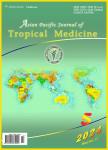Spatial outline of malaria transmission in Iran
Spatial outline of malaria transmission in Iran作者机构:Department of Medical Parasitology and MycologyTehran University of Medical Sciences(TUMS)Iran Climatological Research InstituteMashhadIran Malaria Control ProgramCenter for Diseases Management and Control(CDMC)TehranIran Malaria Control ProgramCenter for Disrases Management and Control(CDMC)TehranIran Dept.of PathobiologyHormozgan University of Medical Sciemces(HUMS).Bandar AbbasIran
出 版 物:《Asian Pacific Journal of Tropical Medicine》 (亚太热带医药杂志(英文版))
年 卷 期:2012年第5卷第10期
页 面:789-795页
核心收录:
基 金:supported by School of Public Health deputy for education Tehran University of Medical Sciences(TUMS) as PhD student project 2010-2012
主 题:Malaria Iran GIS MEWS Epidemiology Mapping
摘 要:Objective:To conduct for modeling spatial distribution of malaria transmission in Iran. Methods:Records of all malaria cases from the period 2008-2010 in Iran were retrieved for malaria control department.MOH&ME.Metrological data including annual rainfall,maximum and minimum temperature,relative humidity,altitude,demographic,districts border shapefiles. and NDVI images received from Iranian Climalologic Research Center.Data arranged in ArcCIS. Results:Results:99.65%of malaria transmission cases were focused in southeast part of Iran. These transmissions had statistically correlation with altitude(650 m),maximum(30℃),minimum (20℃) and average temperature(25.3℃).Statistical correlation and overall relationship between NDVI(118.81),relative humidity(≥45%) and rainfall in southeast area was defined and explained in this study.Conclusions:According to ecological condition and mentioned cut-off points, predictive map was generated using rokriging method.



